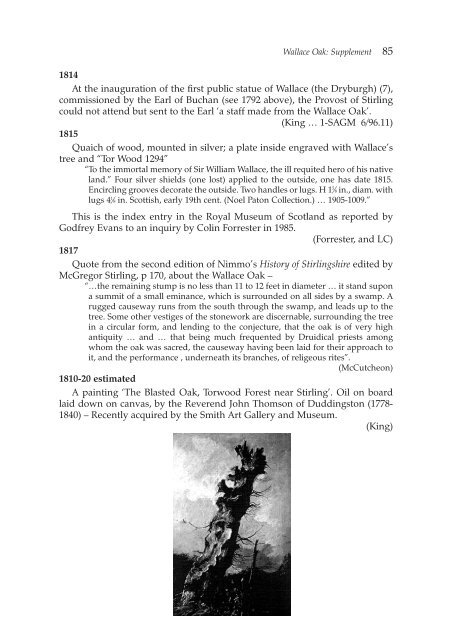the Forth Naturalist Historian - Forth Naturalist and Historian ...
the Forth Naturalist Historian - Forth Naturalist and Historian ...
the Forth Naturalist Historian - Forth Naturalist and Historian ...
Create successful ePaper yourself
Turn your PDF publications into a flip-book with our unique Google optimized e-Paper software.
Wallace Oak: Supplement 85<br />
1814<br />
At <strong>the</strong> inauguration of <strong>the</strong> first public statue of Wallace (<strong>the</strong> Dryburgh) (7),<br />
commissioned by <strong>the</strong> Earl of Buchan (see 1792 above), <strong>the</strong> Provost of Stirling<br />
could not attend but sent to <strong>the</strong> Earl ‘a staff made from <strong>the</strong> Wallace Oak’.<br />
(King … 1-SAGM 6/96.11)<br />
1815<br />
Quaich of wood, mounted in silver; a plate inside engraved with Wallace’s<br />
tree <strong>and</strong> “Tor Wood 1294”<br />
“To <strong>the</strong> immortal memory of Sir William Wallace, <strong>the</strong> ill requited hero of his native<br />
l<strong>and</strong>.” Four silver shields (one lost) applied to <strong>the</strong> outside, one has date 1815.<br />
Encircling grooves decorate <strong>the</strong> outside. Two h<strong>and</strong>les or lugs. H 1 5 ⁄8 in., diam. with<br />
lugs 4 1 ⁄8 in. Scottish, early 19th cent. (Noel Paton Collection.) … 1905-1009.”<br />
This is <strong>the</strong> index entry in <strong>the</strong> Royal Museum of Scotl<strong>and</strong> as reported by<br />
Godfrey Evans to an inquiry by Colin Forrester in 1985.<br />
(Forrester, <strong>and</strong> LC)<br />
1817<br />
Quote from <strong>the</strong> second edition of Nimmo’s History of Stirlingshire edited by<br />
McGregor Stirling, p 170, about <strong>the</strong> Wallace Oak –<br />
“…<strong>the</strong> remaining stump is no less than 11 to 12 feet in diameter … it st<strong>and</strong> supon<br />
a summit of a small eminance, which is surrounded on all sides by a swamp. A<br />
rugged causeway runs from <strong>the</strong> south through <strong>the</strong> swamp, <strong>and</strong> leads up to <strong>the</strong><br />
tree. Some o<strong>the</strong>r vestiges of <strong>the</strong> stonework are discernable, surrounding <strong>the</strong> tree<br />
in a circular form, <strong>and</strong> lending to <strong>the</strong> conjecture, that <strong>the</strong> oak is of very high<br />
antiquity … <strong>and</strong> … that being much frequented by Druidical priests among<br />
whom <strong>the</strong> oak was sacred, <strong>the</strong> causeway having been laid for <strong>the</strong>ir approach to<br />
it, <strong>and</strong> <strong>the</strong> performance , underneath its branches, of religeous rites”.<br />
(McCutcheon)<br />
1810-20 estimated<br />
A painting ‘The Blasted Oak, Torwood Forest near Stirling’. Oil on board<br />
laid down on canvas, by <strong>the</strong> Reverend John Thomson of Duddingston (1778-<br />
1840) – Recently acquired by <strong>the</strong> Smith Art Gallery <strong>and</strong> Museum.<br />
(King)



